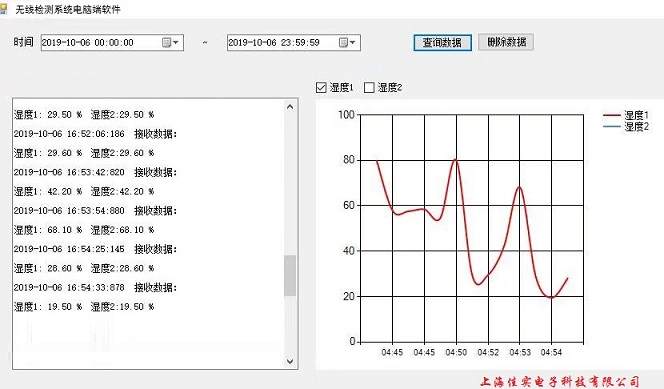


上海佳實電子科技有限公司
主營產品: 傳感器,儀器,云服務
【上海佳實】SH-WL無線多點氣體檢測系統
價格
訂貨量(臺)
¥8.00
≥1
店鋪主推品 熱銷潛力款
莸莶莺莵莹莸莸莼莺莶莵
在線客服
【上海佳實】無線多點檢測系統傳及軟件定做
【上海佳實】SH-WL無線多點測試系統是上海佳實電子科技有限公司基于云平臺應用技術、智能檢測、監測技術、時鐘和環境測量(水分、溫度、濕度、位置、氣體含量等)多種要素開發的系列傳感系統,它不僅具有物聯網無線傳輸的特點,同時具有數據檢測、門限設置、時間(同步、檢測時刻)、采集周期、報警、干擾檢測、軟件更新等獨特的遠程管理功能,使產品從單一的檢測功能、提升為檢測—監測—判斷—報警的功能,非常適合工業領域的檢測、監測、狀態判斷。
一、SH-WL無線傳感器的組成
傳感器是從有線傳感器發展到今天的無線傳感器,SH-WL無線傳感系統包含以下模塊:
1、感知模塊:主要由熱敏元件、光敏元件、氣敏元件、力敏元件、磁敏元件、濕敏元件、聲敏元件、放射線敏感元件、色敏元件和味敏元件等敏感元件組成,用于記錄被監控目標的一些物理學參數。
信息處理模塊:處理模塊由嵌入式系統構成,用于處理存儲感知模塊采集的數據以及其他節點發過來的數據,并負責協調傳感器節點各部分的工作,處理模塊還具有控制電源工作模式的功能,實現節能。
2、無線通信模塊:(傳統有線傳感器和無線傳感器的最本質區別)無線通信模塊的基本功能是將處理器輸出的數據通過無線信道以及傳輸網絡傳送給其他節點或控制中心。
3、能量供應模塊:為其他三個模塊的工作提供能量。
二、無線傳感器組網的基本特點
1、無中心結構:網絡中所有傳感器節點地位對等,并構成一個對等式網絡。節點可以隨時加入和離開網絡,網絡中部分節點發生故障不影響整個網絡的運行。
2、網絡有動態拓撲:無線傳感器網絡中的節點可能由于電池能量耗盡或者故障而從網絡中退出,也可能是按照某種設定的程序從網絡中退出(比如說休眠);網絡外的節點可隨時加入網絡中。
3、高冗余:由于傳感器節點容易出現故障,為了使受損的傳感器節點周圍的其他傳感器節點能夠代替受損的節點繼續工作,所以傳感器網絡的節點一般比較密集,具有高冗余的特點。
硬件資源及功能有限:無線傳感器節點由于受價格、體積和攜載能源的限制,其計算能力、數據處理能力、存儲空間有限,決定了在節點操作系統的設計中,協議層次內容不能過于復雜。
4、電源續航能力較小:網絡節點有電池供電,電池續航能力小,在許多應用場景中無法更換電池。傳感器節點電能用完,該節點就失去了作用,所以在設計傳感器網絡時需要考慮節能。
三、上海佳實的項目
1、按照某大學實驗室要求,制研發并作200+無線傳感器,安裝在森林樹木上,實現1年的連續檢測和傳輸環境溫度、濕度、樹木的水分變化等信息,以備科學研究。
2、按照某大學科研組要求,研發并制作了260+氣體檢測無線傳感器,安裝在工廠內,不間斷檢測廠房內甲醛、VOC、二氧化碳、氧氣等氣體含量的變化,以做科學研究。




[Shanghai Jiashi] SH-WL wireless multi-point test system is based on cloud platform application technology, intelligent detection, monitoring technology, clock and environmental measurement (moisture, temperature, humidity, position, gas content, etc.) A series of sensing systems developed by various elements, which not only have the characteristics of wireless transmission of Internet of Things, but also unique remote data detection, threshold setting, time (synchronization, detection time), acquisition cycle, alarm, interference detection, software update, etc. The management function makes the product from a single detection function to the function of detection-monitoring-judgment-alarm, which is very suitable for detection, monitoring and state judgment in the industrial field.
First, the composition of SH-WL wireless sensor
Sensors are developed from wired sensors to today's wireless sensors. The SH-WL wireless sensing system consists of the following modules:
1. Perceptual module: mainly composed of sensitive elements such as thermal element, photosensitive element, gas sensor, force sensitive component, magnetic sensing component, humidity sensitive component, acoustic sensitive component, radiation sensitive component, color sensitive component and taste sensitive component. Used to record some physical parameters of the monitored target.
Information processing module: The processing module is composed of an embedded system, which is used for processing data collected by the storage sensing module and data sent by other nodes, and is responsible for coordinating the work of various parts of the sensor node, and the processing module also has the function of controlling the working mode of the power source. Achieve energy savings.
2. Wireless communication module: (The most essential difference between the traditional wired sensor and the wireless sensor) The basic function of the wireless communication module is to transmit the data output by the processor to other nodes or control centers through the wireless channel and the transmission network.
3. Energy supply module: Provide energy for the work of the other three modules.
Second, the basic characteristics of wireless sensor networking
1. No central structure: All sensor nodes in the network are in equal status and form a peer-to-peer network. Nodes can join and leave the network at any time. Failure of some nodes in the network does not affect the operation of the entire network.
2, the network has a dynamic topology: nodes in the wireless sensor network may be withdrawn from the network due to battery exhaustion or failure, or may be withdrawn from the network according to some set of procedures (such as sleep); outside the network Nodes can join the network at any time.
3. High redundancy: Since the sensor nodes are prone to failure, in order to enable other sensor nodes around the damaged sensor nodes to continue to work in place of the damaged nodes, the nodes of the sensor network are generally dense and highly redundant.
Limited hardware resources and functions: Due to the limitation of price, volume and carrying energy, wireless sensor nodes have limited computing power, data processing capability and storage space, which determines that the protocol level content should not be too complicated in the design of node operating system.
4, the power endurance is small: the network node has battery power, battery life is small, in many applications can not replace the battery. When the sensor node runs out of energy, the node loses its function, so energy savings need to be considered when designing the sensor network.
Third, Shanghai Jiashi's project
1. According to the requirements of a university laboratory, the system is developed and used as a 200+ wireless sensor. It is installed on forest trees to realize continuous detection and transmission of environmental temperature, humidity, and moisture changes of trees for one year for scientific research.
2. According to the requirements of a university research group, the 260+ gas detection wireless sensor was developed and manufactured in the factory to continuously detect changes in formaldehyde, VOC, carbon dioxide and oxygen in the plant for scientific research.
采購數量不能為空
聯系信息不能為空

驗證碼不正確